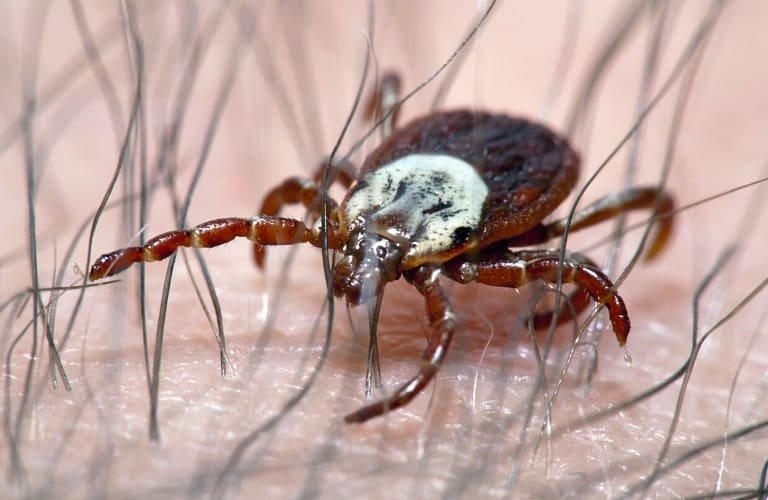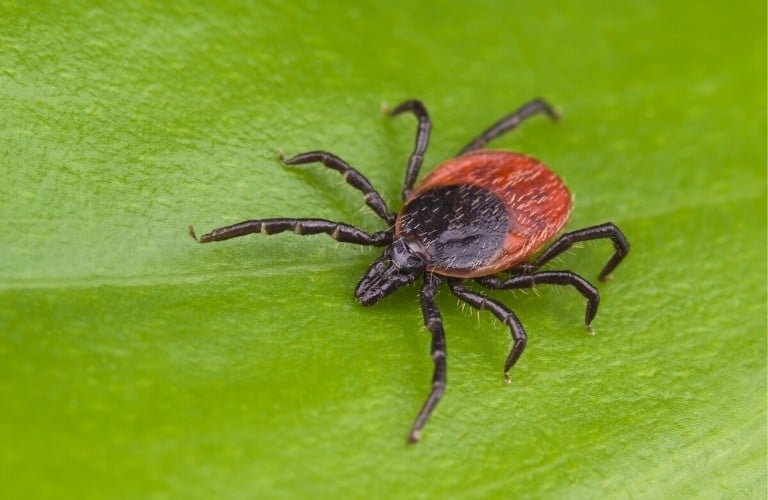If you live in a cold climate, you’ve probably noticed a lull in tick activity when the weather turns cold.
But, if you live in a warm climate, you probably have to deal with them year-round.
If you travel to a different climate, you might not know what to expect when it comes to tick activity.
When do ticks become active? Many ticks are dormant through the winter and will become active once the temperature warms up in March and April. In places where it’s warm year round, ticks will remain active all year. They only go dormant during winters with freezing temperatures.
In the following, you’ll learn about the tick’s life cycle, which tick species may remain active all year, where you’ll likely spot them, and how to best avoid them.
A Tick’s Life Cycle
A tick’s activity is greatly based on its life cycle and survival.
A basic understanding of their life cycle will make it easier to know when and where you can expect to see them.
Like most insects, ticks have four different stages:
- Egg: Eggs are fertilized in the fall and are laid in the following spring. They’re usually laid in piles of leaves or other plant debris, like grass clippings.
- Larva: Larvae emerge late in summer and begin looking for their first host, which is usually a mouse or other small mammal. They feed continuously for a few days and then drop off into a leaf pile to molt into a nymph.
- Nymph: Nymphs search for suitable hosts in the spring and summer after they hatch and continuously feed so they can eventually drop off and go into their final stage. It seems that Lyme disease is mostly transmitted by nymphs.
- Adult: After the tick emerges as a fully grown adult, it once again finds another host to feed on. While on the host, it will find a mate. This happens in the fall and the life cycle repeats.
This is a general explanation of the tick life cycle, but it can vary between species. Some ticks complete the life cycle on one host, some with two, and others with three.
Some species molt several times in the nymph stage and require a blood meal between each stage.
Although it can vary and can even take two years to complete instead of just one, the times of year stay the same for most species.
The more you know about ticks, the better able you’ll be to protect yourself and your family. Click here to access all of our tick articles and learn how to stay safe.
Ticks Are Active When It’s Warm
Ticks need warm weather and humidity to go through their life cycle, so they’re more commonly found in warmer parts of the United States.
If they’re in an area that’s too cold, they’ll go dormant in the winter. Winter doesn’t kill them off; it only causes them to hide until it’s warm again.
The warm weather in March and April signals them to come out of hiding and begin searching for hosts or laying eggs.
If there are adult ticks in the area, you can expect to see larvae hunting for the first time in the fall.
Not All Ticks Go Dormant
Since ticks are active in warm weather, there are some places in the United States where they’re active the entire year.
California, Florida, Mississippi, and other states that are warm and humid (even if only slightly) can expect to see active ticks any time.
The ticks that remain active in the winter include:
- Blacklegged/deer ticks (Ixodes scapularis).
- Western blacklegged ticks (Ixodes pacificus).
- Brown dog ticks (Rhipicephalus sanguineus).
- Rocky Mountain wood ticks (Dermacentor andersoni) – only in lower elevations.
Since many ticks can transmit diseases, your chances of contracting these diseases are higher during tick season.
If you live in a warm environment with ticks that are always active, that means your risk of getting a disease from a tick is higher.
Be careful when you go outside, and be sure that you are not providing an ideal home for them in your yard.
Here in this article, we show you the proper steps to eliminate them from your property and how to avoid being bitten in the process.
The Most Common Places to Find Ticks
Ticks are associated with outdoor areas like hiking trails and camping sites because they’re known to live around trees and shrubs.
This is correct, but there are several other places you can find them (read this for more details) that people don’t usually expect to see them.
Ticks are pretty lazy when it comes to hunting for a host. A tick would rather wait for you to find it rather than it find you.
So, they’ll wait around until a host walks (or scurries) by and will latch onto their clothing or fur.
This means you’ll find them on the edges of things. Since they need humidity, they’ll often be found in areas that retain a bit of moisture.
Look out for ticks around these areas:
- Tall grass: Ticks will climb up tall grass and hang onto the ends of blades when waiting for a host to walk by.
- Tree branches: Ticks will wait for you on low-hanging branches. If you hit your head on a branch, it’s possible for you to pick up a tick or two.
- Piles of leaves and grass: You should never allow grass clippings and leaf piles around your home because ticks love these areas. They’re where they prefer to breed and lay eggs if they don’t do it on a host.
- Wood piles: These can contain moisture and attract rodents, so it’s easy for ticks to find a host, and it’s a comfortable place for them to live.
- Rock and brick walls: If a wall can retain moisture, ticks will live in it. Squirrels (hosts) may climb up these walls, making them an even more ideal place for ticks to live.
- Bird feeders: Ticks will hang around feeders and hop onto a bird when they get the chance.
Maybe it isn’t laziness, but rather a “work smarter, not harder” technique. Because of their hunting method, you have to be careful where you spend your time outdoors.
Preventing Tick Bites
It’s important to take preventive measures when you’re outside, especially in warm areas with year-round tick activity.
Removing ticks is fairly easy (we explain how in this article), but it’s best to avoid them at all costs since they can transmit a variety of diseases, including Lyme disease.
If you’re petrified at the thought of being bitten by a tick, the information found here will help ease your anxiety.
Dress for the Occasion
Tick season requires high fashion, and by that we mean covering yourself from head to toe.
Wear long pants, long-sleeve shirts, tall socks, and closed-toe shoes. Wear a hat in areas with short trees, and consider wearing gloves if your shirt doesn’t have a tight cuff.
Tuck your pants into your socks and your shirt into your pants.
Avoid Their Hiding Spots
This is easier said than done, especially if you’re exploring the outdoors. Wearing proper clothing is your best line of defense if you can’t avoid their areas.
Tucking your pants into your socks will stop the tall grass dwellers, and wearing a hat will stop those hanging out on tree branches.
You may have heard that chickens or guinea fowl can be used to rid your yard of ticks.
However, this may not be as effective (or doable) as you may have hoped. This article explains why attempting this method may not be a great idea.
Tick Repellent
There are two directions you can go with tick repellent: natural and pesticide.
Natural repellents use plant-based ingredients that repel ticks out in the wild.
They’re free of harmful chemicals so they’re safe to use children and pets and won’t damage the environment.
You may have to worry about allergic reactions, however. That’s just part of life.
You can view our full listing of recommended tick sprays here, but for now, we’ll give you both a natural and pesticide option for tick repellents.
For an all-natural choice, we recommend Nantucket Spider Extra Strength Tick Repellent Spray because it only contains natural ingredients and they’re transparent about what they put in their product.
The water-based formula uses steam-distilled, organic essential oils that are proven to repel ticks. The spray has a pleasant vanilla scent and does not leave behind a sticky residue.
If you prefer a pesticide spray, Repel Insect Repellent is a good choice.
It contains 40% DEET which is considered a downside by many, but it’s a long-lasting product that will keep ticks away for several hours.
It shouldn’t be used on young children because of the DEET content, and it may damage plastic, synthetic fabric, leather, and other other surfaces, but it is effective when used correctly.
Final Thoughts
Ticks become active in the spring around March and April and remain active until the first freeze.
If winter doesn’t get cold enough to freeze, ticks will remain active throughout the year.
If you spend time outdoors in grassy or wooded areas, you should make use of tick repellent and long-sleeve clothing so you can prevent picking up ticks while you’re out.
Ticks can transmit many diseases, so stay cautious when you’re outdoors in warm, humid areas.





